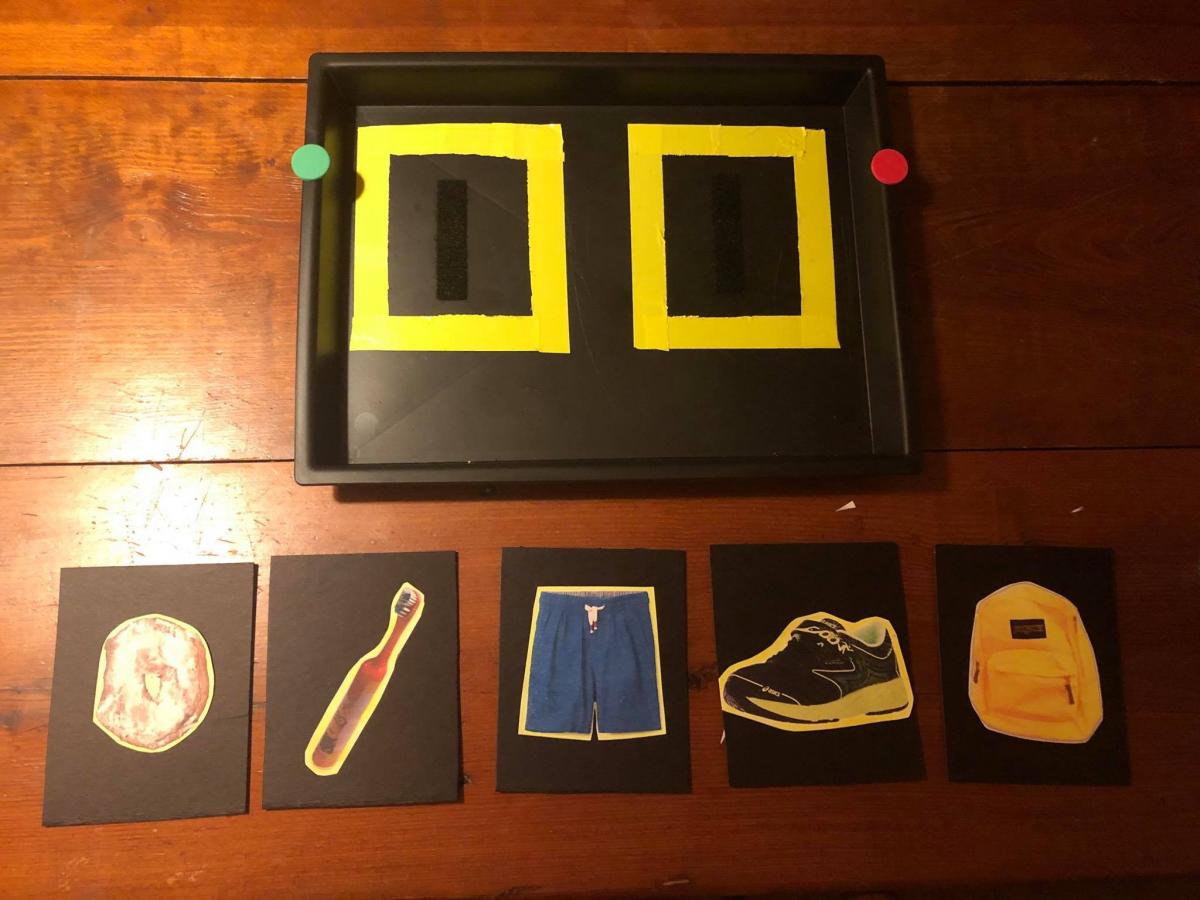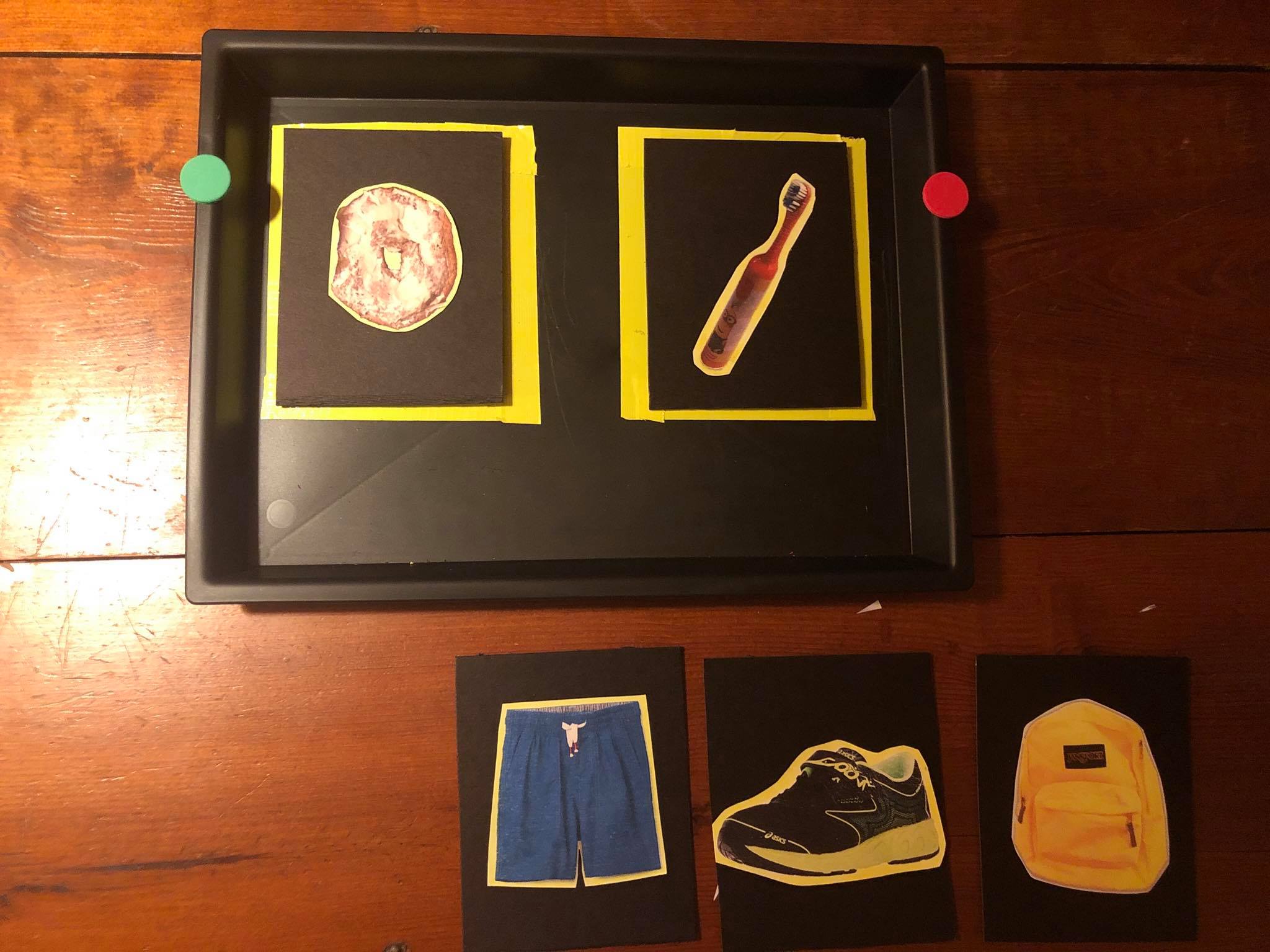After attending Matt Tietjen’s presentation on Coloring Complexity at the Pediatric Cortical Visual Impairment Society conference in June, I decided to adapt this idea for my son Henry. He just turned 6 and just started Kindergarten, and is in Phase II of the CVI Range.
Students with CVI require adapted materials based their CVI Range score and the 10 characteristics. When adapting this for my son, I considered the following CVI characteristics:
- Preferred color (yellow highlighting)
- Complexity (black background; two pictures on the board)
- Novelty (photographs of very familiar objects)
- Visually guided reach (yellow to establish and maintain visual attention while placing picture on board)
- Visual field preference (place on slant board at eye level or above)
- Clear photographs of real items from his daily routine
- Black cardstock
- Glue gun or gluestick
- Black tray
- Velcro strips
- Yellow tape (or tape in whatever the child’s preferred color is)
- Red and green dots
- Before we started using this picture sequence board, we spent a lot of time exploring the real objects and their salient features. These are pictures of his actual items at home and he’s been working to interpret these 2D objects in photographs for some time now. I’ve been describing the salient features of each real object and then continued this salient feature language with the photograph cards.
- I’ve asked him to look at the photograph and then find the object in the house. We’re usually in the room where the item is, but I want to start asking him to navigate his way to the item.
- I’ve also added these photographs into an app called Scene Speak (another recommendation from Matt Tietjen). I can add a hot spot with a recording of me describing the salient features. So he looks at the iPad, taps the item, and then the recording begins.
- I also created a story book about his morning routine using the app, Book Creator, with the same photographs. So we have a lot of wrap-around activities to support the work of the object calendar. The iPad is such a great tool for him—back lighting, reduced complexity, interactivity. Henry still requires prompting to move through this object calendar and some mornings are better than others.
- This picture schedule helps him anticipate his tasks to get ready in the morning. We’re just starting to use it, so I’ve been showing Henry the pictures that represent each task and describing the salient features of the object. I have him place them in order two at a time. For example, first breakfast, then we get dressed. Once Henry gets comfortable with interacting with the board, I want him to work towards choosing the correct picture from 2-3 options after I verbally ask him what’s next. This is hard for him right now, but he’ll get there. He is able to understand what is next when he is told verbally, and he is now working on making that connection with a visual representation of the next activity.
-
The green means “next” and the red dot means “finished”. He hasn’t picked up on this yet, but Matt recommended it as a nice example of using color coding to help organize visual space for kids with CVI. It can also help with left to right sequencing and help guide placement of pictures. (The picture cards have Velcro on the back and are placed on the Velcro strips inside the yellow squares.)

Using the Anticipation Calendar to Support Communication and Behavior Goals
Henry is verbal. He is able to string words in a sentence and follow multi-step directions. He has a hard time organizing multiple pieces of information, so he requires prompting to sequence ideas.
Henry has CVI meltdowns often. He has a difficult time with transitions. Kids with CVI don’t have access to incidental learning or anticipatory information, so he has a hard time orientating himself to a task or understanding time and what is happening next. I’ve been using anticipatory language to help him move through his morning routine. He doesn’t do well with down time, so we have to move at a good clip. But he still has outbursts in the morning. Just this morning, he refused to brush his teeth and move out the door to get in the car. It’s hard, but the anticipatory language and visual schedule are helping with his concept development and his purpose each morning. I also want to begin incorporating a “Finish” bucket, so once he is done with the task he not only removes the photo card, but places it into the finish bucket as just another way help him understand the ideas of starting and stopping a task.
This particular sequence board is for his morning routine, which is when he uses his functional vision the best. I plan to create a similar anticipation calendar for the evening routine.




